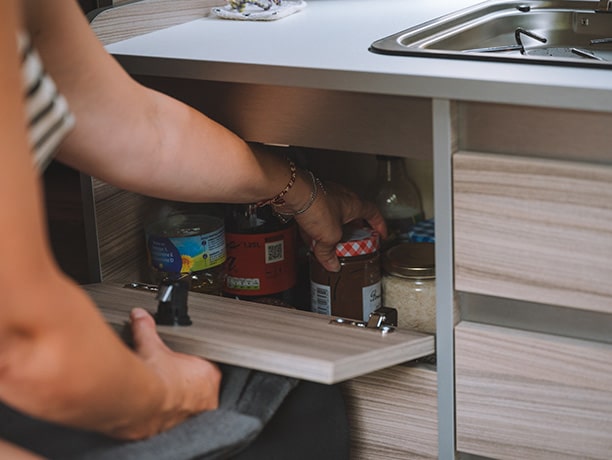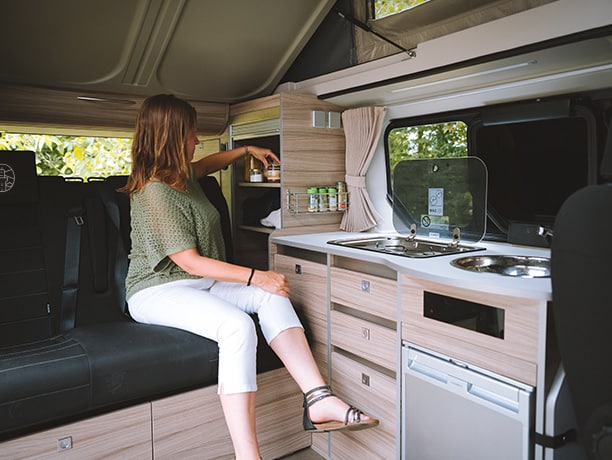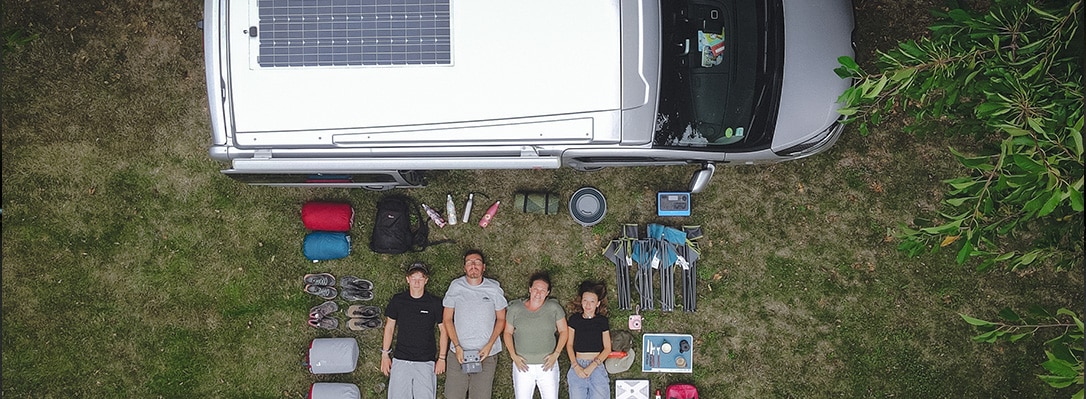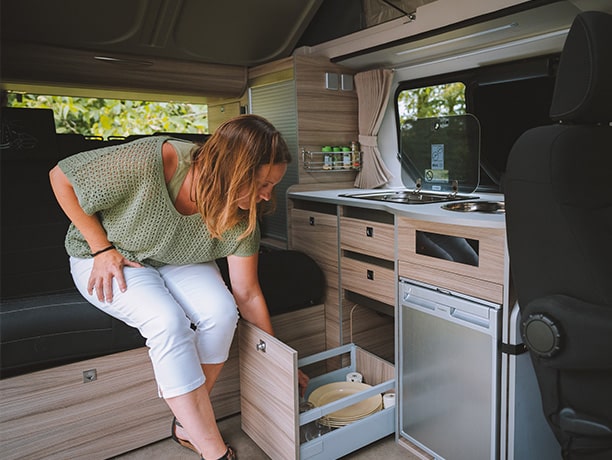A well-prepared family road trip
Preparing your van for a family road trip
Whether you're going on a long or short trip, preparing your converted van requires a great deal of organisation, especially when you're travelling with your family. A "to do list" can be a great help. And then there's the art of Tetris. When you choose a converted van, you have to adapt to the van. The reverse is not possible. So we take the time to make the most of the space available. Here's a quick rundown of our essentials for a successful road trip!
1. Find your destination
Knowing your destination means knowing the weather forecast. This will enable you to decide what is useful and what is not. The type and quantity of clothing, the choice of duvets and footwear will all depend on this. If you're more interested in sunbathing in the Mediterranean in the middle of summer, hiking boots will be of no use. On the other hand, if you're more inclined towards the mountains or Brittany, where the skies are more uncertain, extra warm clothing will be welcome.
The advantage of the van is that the destination can be changed at will, right up to the last minute. The fact that you don't have to book a rental means that you don't have to be in a particular place on a particular day. Once you know where you're going, it's useful to have some documentation on the area to help you make the right choices for activities, spots, sleeping arrangements and eating out.
Planning your itinerary means knowing roughly where you're going. set your travel wishes without planning everything systematically. To make the most of your holiday and vanlife, you'll need to accept the unexpected or a change of route at the moment. Don't plan too many kilometres per day, as this will tire you out more than you need to be and will also prevent you from taking full advantage of the present moment. We usually plan a roadtrip that includes between 50 and 100 km a day, and we think that's plenty of time to enjoy and take it all in.
Leave some time for sightseeing or simply to enjoy the surrounding countryside. If you like riding, consider doing a mix of both: cover the miles for 1 day and then enjoy the leisure activities on site on the second day. Before you leave, take stock of the countries or regions you really want to see and then plan several days there so that you can be guided by your desires when you get there.
This is vanlife: go where you want, when you want and give free rein to our desires and imagination.
2. Organising space inside
As soon as we bought our van, we decided to permanently dedicate compartments to the crockery that remains in the van. This saves us time, ensures that the vehicle is always ready to go, or nearly so, and avoids a line on the 'to do list'. It's a real time-saver when it comes to organisation.
So that you can be self-sufficient as quickly as possible when you're away from home, there's a shelf dedicated to dry food: pasta, rice, semolina, lentils, tea, sandwich bread, tomato sauce, tuna, corn, etc. In short, anything you need to prepare a salad or make a hot dish quickly.
The fridge and how full it is is also an important factor to consider when planning a family roadtrip! Although the fridge is quite spacious, we usually choose to take as little as possible with us, so that we have enough food for the first evening. After that, we make a point of meeting the producers at the markets and going to the shops to buy food in bulk, which means less plastic and less space in the van when it comes to packing.
We have also opted for minimalism. In fact, we ask the children to try and take the bare minimum, whether it's clothes, toiletries or games. And believe me, it's not always easy with teenagers. Sometimes we have to make compromises.
At this age, games (unfortunately) no longer take up much space, if you know what I mean. However, a game of molky, a pack of cards or sheets of paper for a little tray are still essential for the family, so they're always welcome to fill a moment of lack of inspiration. The rule in the van is one bag per person: the children each have their own, and we adults don't forget the camera bag, and the junk bag with lots of things that no-one else thought to take (phone cables, first aid kit, basic sewing kit....). However, toiletry bags tend to get a bit overweight (even for boys, yes!!) so we'll accept it as long as all the family's toiletry bags fit on one shelf.
We also like to fill the van's magazine rack with travel guides, the novels we like to read or a few road maps.



3. Preparing clothes for a van roadtrip
On short trips over a long weekend, for example, we have so far managed to keep one shelf per person for clothes. For longer trips, we've opted for two large but flat 'curver' type cases, one for the parents and one for the children. But the clothes are taking up more and more space, so we're going to have to consider another solution.
These two large boxes are housed in the passenger compartment during transport, and under the van when we settle in for the night. You also have to consider your destination and anticipate the weather. In any case, we never leave without our 'mackintoshes' - you never know. When they're in use, they have their own accessible compartment. When the weather is milder, they spend the journey under the seats, filling empty spaces that don't require regular access. They are there "just in case".
Another important thing to think about is footwear. They need to be easy to put on when getting in and out of the van, they need to be suitable for walking if you're going hiking, but they also need to be 'all-rounders' if you're going to explore towns and villages. In short, a bag containing 2 or 3 pairs of shoes per person should be stowed in the boot.
4. Sleeping equipment
We tried out different sleeping arrangements: with a duvet or with duvets. The duvet made us feel at home and cocooned. But the space they took up in the boot was too much. We couldn't afford it. What's more, the children under the same duvet couldn't stop bickering, especially in the early hours when it was getting cooler. So we opted for duvets. We were a bit sceptical about the quality of the bedding but we invested in 0° and 10° cotton duvets. They enabled us to reconcile ourselves with duvets and sleep well in our van. This notion of sleeping is really different for everyone. So don't hesitate to try out different stays.
Our two beds are good quality and spacious enough for the family. Generally, it's the children who occupy the bedroom upstairs and we parents sleep in the bed downstairs.
This gives them a chance to sleep in or just hang out in bed in the morning. For our part, we can start preparing breakfast and tidying up the bottom bunk.
5. Prepare your van for a safe journey
What's more, preparing your van for departure also means checking all the levels: clean water, electricity, draining dirty water, not forgetting the vehicle's traditional levels. Some manufacturers of converted vans offer this service so you don't have to do it yourself, like Glénan Concept Cars. Whether you're travelling in the summer heat or the winter frost and cold, it's essential to make sure your tyres are suitable, properly inflated and in good condition. And don't forget your warning kit and warning triangle, which are essential if you have a problem on the road. It's when you don't have them that you need them!
We also have a 'catch-all' compartment where we put all the things we probably won't need, but which will be much appreciated if the need arises: a large roll of sturdy scotch tape, washing line and pegs, washing powder, mosquito repellent, mallet, screwdriver kit, etc.
6. The little extras
Generally speaking, when you go on a family trip in a converted van, it's also essential to add folding chairs to the boot so that you can sit outside or sunbathe at the foot of the van. They take up a lot of space in the boot, but we always find a little room for them. Next to them is our toilet block, which we only use in emergency situations in the middle of nowhere.
What's more, as we've travelled more and more, we've felt the need to buy a nomadic external battery, which means we don't have to plug in every time we're camping, and we can use the van to recharge all our electronics (phones, cameras, drone). It fits perfectly in the van between the two front seats. It's so handy that we've rarely forgotten about it.
7. Apps to download to plan your van roadtrip
Certain applications are proving to be indispensable for the ideal road-trip with your family. They can be used to find your way around, to find a parking space for the night, to find places to fill up with water or even to find a shop a stone's throw away. Here are a few that you won't be able to do without once you've tried them out - they're with us every day, whether it's for a weekend just around the corner or a more distant trip.
- Google Mapsto find shops, car parks or simply as a GPS device
- Park4NightIt lists places to spend the night, nearby leisure activities and motorhome parks where you can empty your caravan or motorhome. water tanks.
- France Passion: to meet producers, winegrowers or other farmers
- Essence&Co : the app that takes you to the nearest service station!
- Tripadvisor : to eat at some of the best restaurants in the region.
- Freetaps : to find drinking water.
- Where are the toilets? : so you're never caught short by a pressing urge.
In conclusion
To get the most out of a van road-trip, you have to let your instincts guide you. In any case, that's usually our credo.
You have to hit the road while giving yourself the chance to stop whenever and wherever you want to enjoy a beautiful landscape, visit a historic site or simply take your time. But don't neglect to plan ahead. You'll need to make a forecast expenditure and manage your budget in real timeOtherwise you could be in for a nasty surprise!
If you are planning to leave French territory, the take out private insurance will be essential to cover your medical expenses abroad, for example. You'll also need to download the best road-trip apps and take along a few accessories that you won't be able to do without on your return.
And don't forget the most important thing: an open mind which will enable you to discover unexpected things and meet some wonderful people along the way.

